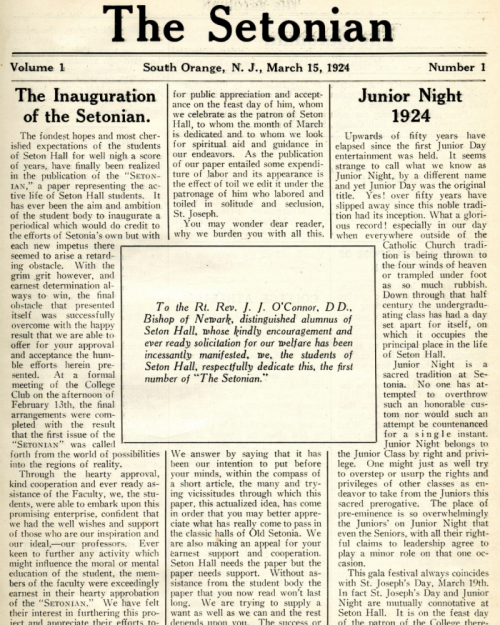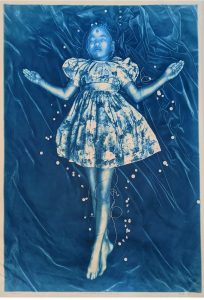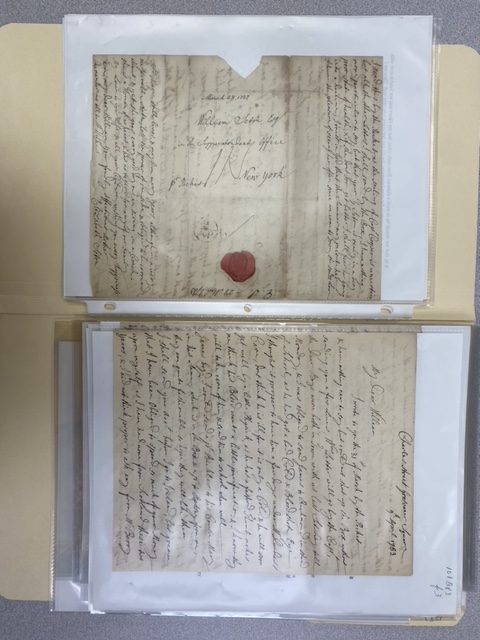The Time Machines project, which supports undergraduate research in Special Collections, is off to a great start. The sheer diversity of the projects—podcasts, a map of climate change in the Arctic, even a cookbook —showcase just how diverse primary source-based research can be. Read on to learn more about our student researchers, their proposals, and how their projects are going thus far.
Pegi Bracaj
Object of Choice: The Miriam Rooney Papers
Pegi Bracaj is a political science student with aspirations for a career in law upon graduation. She was drawn to the papers of Miriam Rooney, the founding dean of Seton Hall Law School and the first female dean of a law school in the United States. Pegi decided to expand upon the primary source material by creating a multi-episode podcast series. The first episode will be dedicated to Rooney’s life as based on the archival findings. In later episodes, she plans to “contextualize Miriam Rooney’s accomplishments in the context of the broader legal history, showcasing her influence on subsequent generations of female lawyers”. Through interviews with current female lawyers at Seton Hall Law School, Pegi seeks to connect Miriam Rooney’s life to the ongoing discussion and challenges faced by women in the legal sphere today.
Ashley Skladany
Object of Choice: Collection of 1967 Newark Rebellion Newsclippings
Ashley focused her project on the 1967 Newark Riots and its impact on the campus through two mediums-an academic paper and a podcast. As a technical producer of the Global Current, the official international affairs podcast of SHU’s School of Diplomacy, Ashley will utilize her skills to record and edit a podcast that interviews individuals who attended the university at the time or who were impacted.
Eman Fatima
Object of Choice: Coin from the Mughal Dynasty ; Coin, ¼ Anna
Eman Fatima spent the first sixteen years of her life in Pakistan and describes her interest in history and decolonization stemming from a lack of substantial education on British colonialism (particularly in South Asian countries) in schools’ curriculum. In wanting to explore how colonialism has molded and continues to mold the identity, culture, and daily life in South Asian society, Eman intends to write an academic paper comparing two coins: one from the Mughal Dynasty, and the other from the 17th century amid British rule over India and Pakistan.
Collin Doyle
Object of Choice: Journal of Roy Fitzsimmons, 1937-1938*
Collin came to the Archives upon hearing that the Archives had recently acquired the journal of Roy Fitzsimmons (SHU class of 1937), a physicist and polar explorer who took said journal on the MacGregor Arctic Expedition from July 1, 1937 – October 4, 1938. The goals of the expedition were to conduct a magnetic survey, collect weather data, photograph the aurora borealis and study its effects upon radio transmission, and to explore the area northwest of Ellesmere Island. Collin intends to create a data visualization project incorporating computer algebra systems such as Mathematica to generate 3D maps, as well as contour plots, of the arctic landscapes explored by Roy Fitzsimmons in the late 1930s, with the goal of highlighting the effects of climate change over the last century. Through this medium, Collin seeks to “breathe life into the journal’s observations” while providing commentary on the urgency of climate change and the threat it poses to our society and planet as a whole.
*Journal is not currently available online but is available to view at the Archives by appointment.
Hope Mahakian
Object of Choice: WWII Ration Books, 1943
Hope, a History major, has always been interested in the effects of WWII on the American home front. When researching possible items for this project she came across the WWII ration books but was not initially interested in pursuing them. However, after a trip to the Archives and viewing the object for herself, research questions began to emerge–”Who is or was the person that owned them? What were they used for? What do the different stamps mean? Why were some used more than others?” After discovering that all the ration books were owned by women, who were most likely in the same family, Hope decided to take a more personal approach to this project by creating her own cookbook based on the recipes that were created or became more popular due to rationing. In addition, she intends to also create a short video in the style of a 1940s infomercial, complete with filters and wardrobe choices to create the proper aesthetic, where herself and fellow actors cook the recipes themselves. Through both of these mediums Hope intends to convey what rationing looked like and how it differed across different types of families.
Austin DelSontro
Object of Choice: Setonian Newspapers, 1924-2019
Inspired by the 100th anniversary of The Setonian, Seton Hall’s student run newspaper, Austin approached this project wanting to explore not only how campus life has changed over the course of 100 years, but what has remained the same. Further, Austin’s research will focus on the evolution of writers, the topics covered over the years, and the response to significant cultural/political events over the past 100 years. While Austin’s primary project will be an academic paper, he also intends to supplement a digital component, such as a website or a blog, and use images to illustrate key differences. Austin is also exploring the possibility of creating his own personalized newspaper, inspired by The Setonian itself, to provide a comprehensive overview of his research findings.
Final projects will be shared with the community in April 2024. Stay tuned for more updates—we cannot wait to see how they will turn out!


